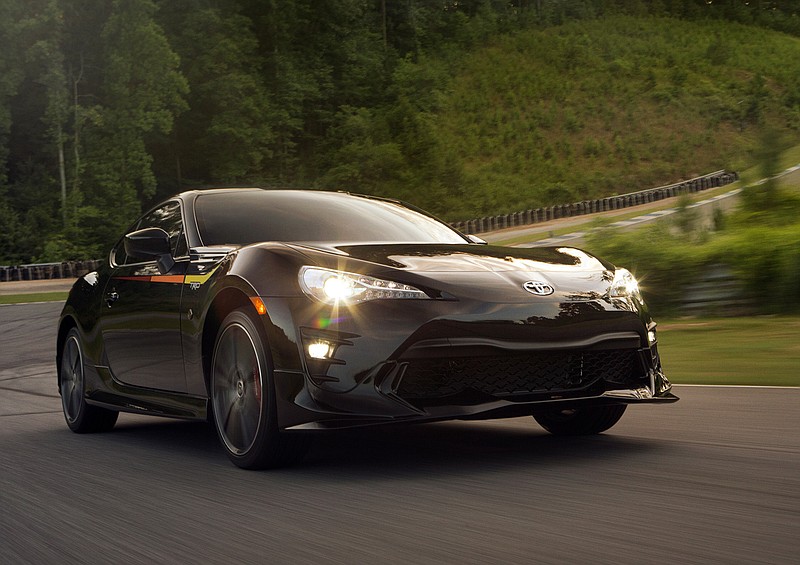What a great time this is to be a lover of sports cars: Tight handling roadsters are better than ever, but few people want them, so prices are affordable.
Case in point, the 2019 Toyota 86, kissing cousin to the Toyota BRZ, a machine with notable flaws to be sure, but beyond doubt the best driving sports car for less than $30,000 on the planet. Sure, it's not as quick off the line as Detroit muscle, but once the curves show up the little 2+2 will leave Mustangs, Camaros and Chargers sniffing naught but the memory of its presence and wondering if that speck on the horizon is the machine it is chasing.
Traipsing through the twisties in triple digits on the famed river bottoms run, our tester seemed to have no limits. Oh sure, there was some slight body lean, a nod to driver and passenger comfort, but we quickly learned that if we gave into it the car would find the straightest line through the challenge.
Our tester came equipped with a standard six-speed manual transmission. It allowed the 2.0-L Subaru Boxer engine to show its stuff. At mid-range, the torquey little power plant sings like a baritone in full voice. Pushed out toward its 7500 redline, it became a masculine tenor announcing its presence across the dark and barren countryside. Now that is a satisfying exhaust note.
Yours truly has long been an unabashed supporter of the Mazda MX-5 and have secretly longed to put one in the garage as my last-purchase, bucket-list, geezer-mobile.
"That's not practical," I was informed by Beautiful Blonde, the great love of my life, who obviously missed this particular point. At our ages, we have a surfeit of practicality. A little bit of occasionally illegal driving to get the blood flowing is just what our platoon of doctors recommends. Or should.
The 86 changed my mind, not about the driving, but about the object of my affection. In price, capability and reputation for endurance, the 86/BRZ is the equal of the MX-5. Send both down a straightaway and through a series curves, however, and the Miata, or its first cousin, the more powerful Fiat 124 Spider, would exit the final apex imitating Mel Blanc's befuddled beagle.
The Boxer engine has so much top-end guts it will leave the Miata like a jack rabbit out running a prairie fire.
"Which way did he go George? Which way did he go?"
Safety third
If you asked for my recommendation of an affordable sports car, I would probably try to duck the question because I know that the limited handling and mediocre reliability of a Mustang, Camaro or Charger are good enough for most Americans.
I'll not disagree that these are good cars; indeed, Americans bought nearly 140,000 of them last year. They have more trunk and rear seating space, more mass-nearly a thousand pounds-and provide more power and similar fuel economy with their base engines. The new Camaro, with the new 1LE package, is a quite competent curve hugger at $30,995.
Start upgrading to the available V-6 and V-8 engines-the stuff of American kids' dreams-and one is quickly in $35,000 to $60,000 range for car with limited demand. Can you spell depreciation? In a real race, the heft it takes to generate all that power is a hazard. Sometimes it's about entrance speed, sometimes its about how fast one exits a curve, but the bottom line is it doesn't matter how many horses a car has if you're mashing on the brake and the other fella is into the throttle.
One thing all these sports cars lack, however, is a full complement of driver assist technologies. Ford, for example, sells a safe and smart package ($1,000) that includes adaptive cruise control and lane-keep alert, but not lane-keep assist. The former gives you a warning, the latter keeps the car between the lines and avoids accidents. Other nice things, like blind spot monitoring, are not included.
Still, Ford is way ahead of Toyota's, Fiat's, and Mazda's sports cars, which do not offer driver assist tech at any price. This represents a sidestep for Toyota, the industry leader in driver-assist tech which offers-standard-a full suite on everything except the 86 and 4Runner.
To be sure, the 86 is still a safe car. It comes with Toyota's Star safety system which features anti-lock brakes, electronic brake force distribution, traction control, brake assist, vehicle stability control, and smart-stop technology.
That was state of the art just five years ago, but now we have entered the age of semi-autonomous cars that always pay attention and take actions that reduce can accidents, injuries, and deaths by up to 40 percent. It is hard to justify a five- or six-year loan on a new car that does not compete technologically.
One can have those things, and a long list of other desirable features, in a sporty car that has an actual backseat. Look at the Honda Civic Sport and Hyundai Veloster Turbo for cars under $30,000 that are fun to drive and offer a ton of that dreaded practicality.
Too much for my taste, to be honest, but at my age death is less an anathema than enduring boring days.
Zoom-zoom.
Built like a sports car
In any showdown of affordable sports cars, the 86 brings a couple of sharp knives to the fight.
The first is the Boxer engine, so named because the cylinders are aligned horizontally, with the pistons going at each other like a pair of boxers. The low profile has several inherent advantages, such as improved coolant and oil circulation, but the big plus is that the engine sits low, dropping the car's center of gravity.
The 2.0-liter aluminum engine delivers 205 hp at 7,000 rpm and 156 lb.-ft. of peak torque at 6,400 rpm. The 86 mm x 86 mm bore and stroke dimensions make the engine a high revver, yet dual variable valve timing helps give it a broad torque curve. So, the 86 feels highly responsive in everyday driving.
An available automatic is geared lower and puts out 200 hp at 7,000 rpm and 151 lb.-ft. at 6,400 rpm. It's not as quick but gets better fuel economy than the standard: up to 32 mpg highway, compared to 28 for the manual.
The chassis is a specially developed rear-drive sports car platform. It uses sport-tuned struts in front suspension and a sport-tuned independent multi-link rear suspension with reinforcement bracing. The electric power-assist steering is quick, with just 2.48 turns lock-to-lock, and with a tight 36.1-ft. turning circle. It's also highly articulate, providing ideal road feel through the small-diameter, leather-wrapped wheel.
We've had the opportunity to take a couple of cars out on closed-circuit, motocross circuits, flip off the traction control and have at it. It's an exceptionally rewarding experience. The car remains highly predictable, even when sashaying its rear-end around like oh, let's not complete that simile.
Shop used
Like the Miata, the Toyota 86/Subaru BRZ has been around a while and plenty of low-mileage ones are on the market. Toyota marketed this as the Scion FR-S through 2016. The 2017 Toyota 86 is mechanically nearly identical, though the changeover to Toyota brought some welcome exterior touches and a more refined cabin.
The last two model years have brought almost no change and there is plentiful supply of slightly used 86/BRZ models on the market at $10,000 or more below original price.
So, when I finally do make this purchase, will it be an 86 or Miata? Ehhh, the Miata is a convertible. Though it is still fun to put a wonderfully balanced, right-powered sports car through its paces, it is equally rewarding to drop the top for a leisurely Sunday drive.
I mean, what's the hurry?
Bottom line
There is nothing practical about a Toyota 86, but-speaking from experience-every young man should own at least one open-top sports car. That may be true for older men, too.



